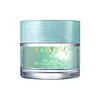What's inside
What's inside
 Key Ingredients
Key Ingredients

 Benefits
Benefits

 Concerns
Concerns

No concerns
 Ingredients Side-by-side
Ingredients Side-by-side

Snail Secretion Filtrate
Skin ConditioningButylene Glycol
HumectantCyclopentasiloxane
EmollientGlycerin
HumectantBis-PEG-18 Methyl Ether Dimethyl Silane
EmollientPolysorbate 20
EmulsifyingSodium Hyaluronate
HumectantCarbomer
Emulsion StabilisingGlycosyl Trehalose
Emulsion StabilisingHydrogenated Starch Hydrolysate
HumectantTriethanolamine
BufferingDimethicone/Vinyl Dimethicone Crosspolymer
Skin ConditioningDimethicone
EmollientHydroxyethylcellulose
Emulsion StabilisingCaprylyl Glycol
EmollientEthylhexylglycerin
Skin ConditioningSodium Polyacrylate
AbsorbentCentella Asiatica Extract
CleansingPortulaca Oleracea Extract
Skin ConditioningCamellia Sinensis Leaf Extract
AntimicrobialNelumbo Nucifera Flower Extract
Skin ConditioningBetula Platyphylla Japonica Juice
Skin ConditioningTropolone
Skin ConditioningCopper Tripeptide-1
Skin ConditioningAllantoin
Skin ConditioningPanthenol
Skin ConditioningOlea Europaea Fruit Oil
MaskingHelianthus Annuus Seed Oil
EmollientPalmitoyl Pentapeptide-4
Skin ConditioningAdenosine
Skin ConditioningDisodium EDTA
Snail Secretion Filtrate, Butylene Glycol, Cyclopentasiloxane, Glycerin, Bis-PEG-18 Methyl Ether Dimethyl Silane, Polysorbate 20, Sodium Hyaluronate, Carbomer, Glycosyl Trehalose, Hydrogenated Starch Hydrolysate, Triethanolamine, Dimethicone/Vinyl Dimethicone Crosspolymer, Dimethicone, Hydroxyethylcellulose, Caprylyl Glycol, Ethylhexylglycerin, Sodium Polyacrylate, Centella Asiatica Extract, Portulaca Oleracea Extract, Camellia Sinensis Leaf Extract, Nelumbo Nucifera Flower Extract, Betula Platyphylla Japonica Juice, Tropolone, Copper Tripeptide-1, Allantoin, Panthenol, Olea Europaea Fruit Oil, Helianthus Annuus Seed Oil, Palmitoyl Pentapeptide-4, Adenosine, Disodium EDTA
Water
Skin ConditioningDipropylene Glycol
HumectantButylene Glycol
HumectantPropanediol
SolventGlycereth-26
HumectantBetaine
Humectant1,2-Hexanediol
Skin ConditioningGlycerin
HumectantHexylene Glycol
EmulsifyingHydroxyacetophenone
AntioxidantSodium Carbomer
Emulsion StabilisingTrehalose
HumectantPolyglyceryl-10 Myristate
Skin ConditioningSea Water
HumectantPanthenol
Skin ConditioningMethyl Diisopropyl Propionamide
MaskingDisodium EDTA
Sodium Hyaluronate
HumectantBeta-Glucan
Skin ConditioningMelia Azadirachta Leaf Extract
Skin ConditioningHouttuynia Cordata Extract
Skin ConditioningChondrus Crispus Extract
Skin ConditioningMaltodextrin
AbsorbentMelia Azadirachta Flower Extract
Skin ConditioningHydrolyzed Vegetable Protein
Skin ConditioningChlorella Vulgaris Extract
Skin ConditioningHizikia Fusiforme Extract
Skin ConditioningUndaria Pinnatifida Extract
Skin ConditioningLaminaria Japonica Extract
Skin ProtectingGelidium Cartilagineum Extract
Skin ProtectingHydrolyzed Gardenia Florida Extract
AntioxidantSea Salt
AbrasiveCynanchum Atratum Extract
Skin ConditioningWater, Dipropylene Glycol, Butylene Glycol, Propanediol, Glycereth-26, Betaine, 1,2-Hexanediol, Glycerin, Hexylene Glycol, Hydroxyacetophenone, Sodium Carbomer, Trehalose, Polyglyceryl-10 Myristate, Sea Water, Panthenol, Methyl Diisopropyl Propionamide, Disodium EDTA, Sodium Hyaluronate, Beta-Glucan, Melia Azadirachta Leaf Extract, Houttuynia Cordata Extract, Chondrus Crispus Extract, Maltodextrin, Melia Azadirachta Flower Extract, Hydrolyzed Vegetable Protein, Chlorella Vulgaris Extract, Hizikia Fusiforme Extract, Undaria Pinnatifida Extract, Laminaria Japonica Extract, Gelidium Cartilagineum Extract, Hydrolyzed Gardenia Florida Extract, Sea Salt, Cynanchum Atratum Extract
 Reviews
Reviews

Ingredients Explained
These ingredients are found in both products.
Ingredients higher up in an ingredient list are typically present in a larger amount.
Butylene Glycol (or BG) is used within cosmetic products for a few different reasons:
Overall, Butylene Glycol is a safe and well-rounded ingredient that works well with other ingredients.
Though this ingredient works well with most skin types, some people with sensitive skin may experience a reaction such as allergic rashes, closed comedones, or itchiness.
Learn more about Butylene GlycolDisodium EDTA plays a role in making products more stable by aiding other preservatives.
It is a chelating agent, meaning it neutralizes metal ions that may be found in a product.
Disodium EDTA is a salt of edetic acid and is found to be safe in cosmetic ingredients.
Learn more about Disodium EDTAGlycerin is already naturally found in your skin. It helps moisturize and protect your skin.
A study from 2016 found glycerin to be more effective as a humectant than AHAs and hyaluronic acid.
As a humectant, it helps the skin stay hydrated by pulling moisture to your skin. The low molecular weight of glycerin allows it to pull moisture into the deeper layers of your skin.
Hydrated skin improves your skin barrier; Your skin barrier helps protect against irritants and bacteria.
Glycerin has also been found to have antimicrobial and antiviral properties. Due to these properties, glycerin is often used in wound and burn treatments.
In cosmetics, glycerin is usually derived from plants such as soybean or palm. However, it can also be sourced from animals, such as tallow or animal fat.
This ingredient is organic, colorless, odorless, and non-toxic.
Glycerin is the name for this ingredient in American English. British English uses Glycerol/Glycerine.
Learn more about GlycerinPanthenol is a common ingredient that helps hydrate and soothe the skin. It is found naturally in our skin and hair.
There are two forms of panthenol: D and L.
D-panthenol is also known as dexpanthenol. Most cosmetics use dexpanthenol or a mixture of D and L-panthenol.
Panthenol is famous due to its ability to go deeper into the skin's layers. Using this ingredient has numerous pros (and no cons):
Like hyaluronic acid, panthenol is a humectant. Humectants are able to bind and hold large amounts of water to keep skin hydrated.
This ingredient works well for wound healing. It works by increasing tissue in the wound and helps close open wounds.
Once oxidized, panthenol converts to pantothenic acid. Panthothenic acid is found in all living cells.
This ingredient is also referred to as pro-vitamin B5.
Learn more about PanthenolSodium Hyaluronate is hyaluronic acid's salt form. It is commonly derived from the sodium salt of hyaluronic acid.
Like hyaluronic acid, it is great at holding water and acts as a humectant. This makes it a great skin hydrating ingredient.
Sodium Hyaluronate is naturally occurring in our bodies and is mostly found in eye fluid and joints.
These are some other common types of Hyaluronic Acid:
Learn more about Sodium Hyaluronate